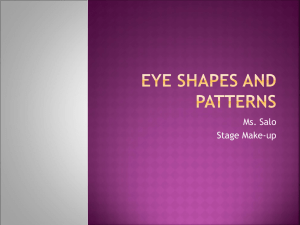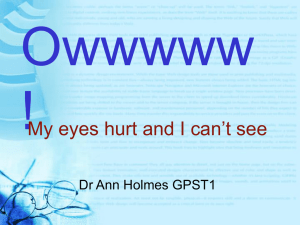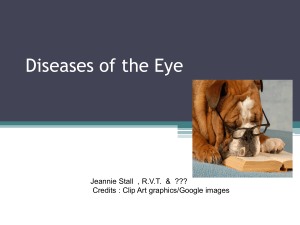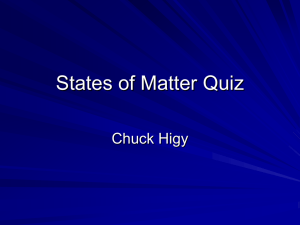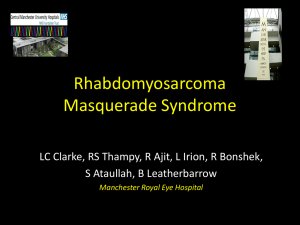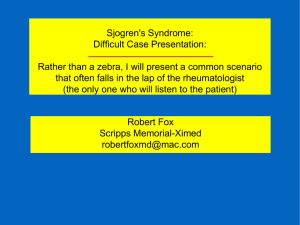Pink Eyes - Funandeducation.org
advertisement
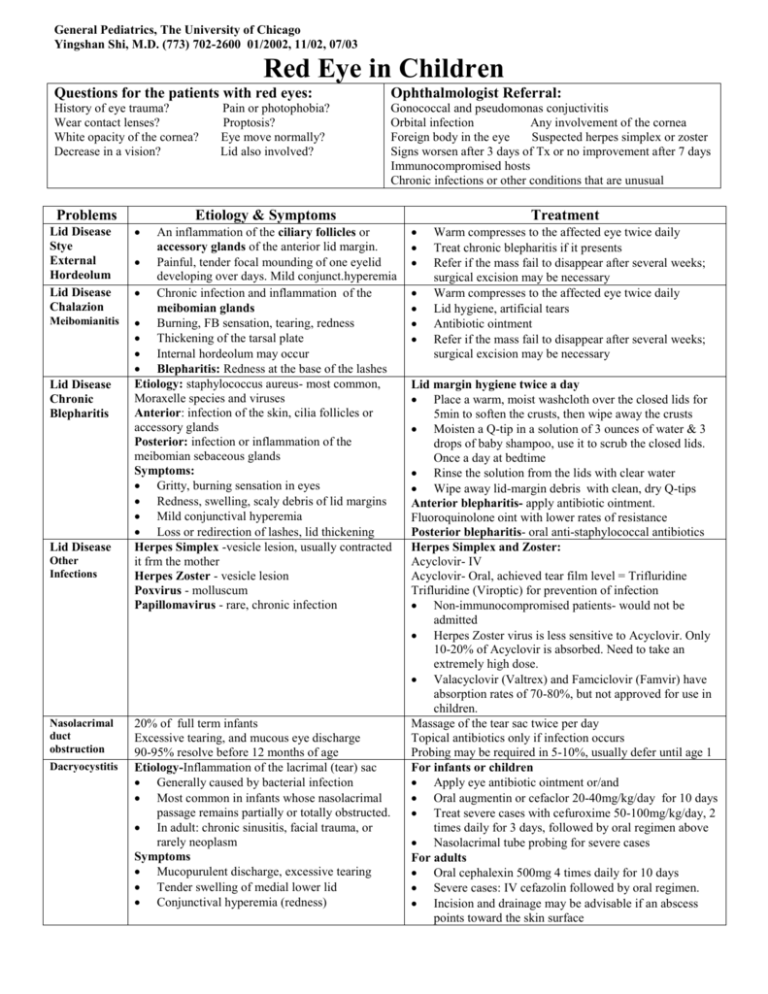
General Pediatrics, The University of Chicago Yingshan Shi, M.D. (773) 702-2600 01/2002, 11/02, 07/03 Red Eye in Children Questions for the patients with red eyes: Ophthalmologist Referral: History of eye trauma? Wear contact lenses? White opacity of the cornea? Decrease in a vision? Gonococcal and pseudomonas conjuctivitis Orbital infection Any involvement of the cornea Foreign body in the eye Suspected herpes simplex or zoster Signs worsen after 3 days of Tx or no improvement after 7 days Immunocompromised hosts Chronic infections or other conditions that are unusual Problems Lid Disease Stye External Hordeolum Lid Disease Chalazion Meibomianitis Lid Disease Chronic Blepharitis Lid Disease Other Infections Nasolacrimal duct obstruction Dacryocystitis Pain or photophobia? Proptosis? Eye move normally? Lid also involved? Etiology & Symptoms An inflammation of the ciliary follicles or accessory glands of the anterior lid margin. Painful, tender focal mounding of one eyelid developing over days. Mild conjunct.hyperemia Chronic infection and inflammation of the meibomian glands Burning, FB sensation, tearing, redness Thickening of the tarsal plate Internal hordeolum may occur Blepharitis: Redness at the base of the lashes Etiology: staphylococcus aureus- most common, Moraxelle species and viruses Anterior: infection of the skin, cilia follicles or accessory glands Posterior: infection or inflammation of the meibomian sebaceous glands Symptoms: Gritty, burning sensation in eyes Redness, swelling, scaly debris of lid margins Mild conjunctival hyperemia Loss or redirection of lashes, lid thickening Herpes Simplex -vesicle lesion, usually contracted it frm the mother Herpes Zoster - vesicle lesion Poxvirus - molluscum Papillomavirus - rare, chronic infection 20% of full term infants Excessive tearing, and mucous eye discharge 90-95% resolve before 12 months of age Etiology-Inflammation of the lacrimal (tear) sac Generally caused by bacterial infection Most common in infants whose nasolacrimal passage remains partially or totally obstructed. In adult: chronic sinusitis, facial trauma, or rarely neoplasm Symptoms Mucopurulent discharge, excessive tearing Tender swelling of medial lower lid Conjunctival hyperemia (redness) Treatment Warm compresses to the affected eye twice daily Treat chronic blepharitis if it presents Refer if the mass fail to disappear after several weeks; surgical excision may be necessary Warm compresses to the affected eye twice daily Lid hygiene, artificial tears Antibiotic ointment Refer if the mass fail to disappear after several weeks; surgical excision may be necessary Lid margin hygiene twice a day Place a warm, moist washcloth over the closed lids for 5min to soften the crusts, then wipe away the crusts Moisten a Q-tip in a solution of 3 ounces of water & 3 drops of baby shampoo, use it to scrub the closed lids. Once a day at bedtime Rinse the solution from the lids with clear water Wipe away lid-margin debris with clean, dry Q-tips Anterior blepharitis- apply antibiotic ointment. Fluoroquinolone oint with lower rates of resistance Posterior blepharitis- oral anti-staphylococcal antibiotics Herpes Simplex and Zoster: Acyclovir- IV Acyclovir- Oral, achieved tear film level = Trifluridine Trifluridine (Viroptic) for prevention of infection Non-immunocompromised patients- would not be admitted Herpes Zoster virus is less sensitive to Acyclovir. Only 10-20% of Acyclovir is absorbed. Need to take an extremely high dose. Valacyclovir (Valtrex) and Famciclovir (Famvir) have absorption rates of 70-80%, but not approved for use in children. Massage of the tear sac twice per day Topical antibiotics only if infection occurs Probing may be required in 5-10%, usually defer until age 1 For infants or children Apply eye antibiotic ointment or/and Oral augmentin or cefaclor 20-40mg/kg/day for 10 days Treat severe cases with cefuroxime 50-100mg/kg/day, 2 times daily for 3 days, followed by oral regimen above Nasolacrimal tube probing for severe cases For adults Oral cephalexin 500mg 4 times daily for 10 days Severe cases: IV cefazolin followed by oral regimen. Incision and drainage may be advisable if an abscess points toward the skin surface General Pediatrics, The University of Chicago Yingshan Shi, M.D. (773) 702-2600 01/02, 11/02, 07/03 Red Eye in Children Problems Etiology & Symptoms Conjunctivitis Neoanatal - Ophthalmia Neonatorum Chemical - 1st 24 hours of life Gonococcal -day 2-5, usually bilaterally Chlamydial -days/wks after birth, often unilaterally. 50% of untreated chlamedial conjuctivits develop pneumonitis and otitis media. Other bacterial infections Herpes - 7-14 days of age Bacterial -purulent discharge, esp. unilateral 1st-H. Influenzae(gram neg), 2nd-Strep pneumoniae, 3rd-Morexella caterrhalis (gram neg) Diffuse and marked conjunctival hyperemia Usually resolve within 8-10 days Viral - watery or mucoid discharge, Most caused by adenovirus, highly contagious. Hx of exposure, incubation period is about 8 d Diffuse conjunctival hyperemia with follicles. Tender preauricular node Monocular or binocular involvement. Keratitis in some patients: slightly degraded vision, foreign body sensation, & photophobia. Pharyngoconjunctival fever may present Herpes simplex: typically 7-10 yrs Allergic - stringy white mucoid discharge Usually seasonal and tends to follow URI. Always bilateral. Itching, photophobia & eye lid swelling. Burning, tearing, foreign body sensation Boggy, hyperemic conjunctiva. Conjunctival hyperplasia -cobblestone papillae and ptosis Vernal keratoconjuctivitis-severe allergy Corneal inflammation or shield ulcers 5% with permanent visual changes PreseptalPeri-orbital Cellulitis PostseptalOrbital Cellulitis Corneal abrasion Other Treatment Ophthalmia Neonatorum Need a smear and a culture Requires systemic treatment Exam parents and caretaker for possible source Bacterial Conjunctival scraping for smears and cultures in affected infants and in immunocompromised hosts. Topical antibiotics. Fluoroquinolones-most effective Eye drop remains in the eye only about 10minutes Oint can be applied on the lid margin with a clean finger or run a strip along the margin N. Gonorrhoeae conjunctivitis: Red book- IM or IVceftriaxone Most ophthalmologist- topical as well as systemically Such as erythromycin ointment Irrigate the eye with saline Refer if Neisseria conjunctivitis is suspected; use overnight contact lenses; has recent surgery; signs worsen after 3 days of Tx or no improvement after 7 days; immunocompromised hosts and has history of injury with a foreign body. Viral Avoid attending school as long as discharge present. Warm or cool compress and artificial tears Refer if symptoms worse or keratitis suspected. Allergic Combination antihistamine and mast cell stabilizers are the most effective treatment Topical 0.1% Patanol-antihistamine.3yr Naphcon 0.01-0.02%sol- vasoconstrictor/antihistamine Ketorolac 0.5% sol (Acular) anti-inflammatory Azelastine HCL-antihistamine+mast cell stabilizer 3yr Shield cornea ulcer - cool compresses, steroid by eye specialists Systemic antihistamine- tend to cause dry eyes Preseptal Consider full sepsis work up including a lumbar Bacterial infections of periocular tissues, puncture for children with toxicity or for any patient commonly from infected paranasal sinuses with possible orbital cellulitis Fever or symptoms of URI Refer immunocompromised hosts and patients with a eye motility disturbance to ophthalmologist to determine Upper & lower lids swelling, usually unilateral which imaging should take place. Mild, diffuse conjunctival hyperemia Systemic antibiotics Tenderness of lids and globe 1st generation antistaphylococcal antibiotics for Postseptal-involves posterior 2/3 of the orbit preseptal infection caused by S. aureus Reduced ocular movement, proptosis 3rd generation antibiotic for postseptal infection caused Visual loss- uncommon by Pneumococcus and H. Influenzae Tearing, redness, and photophobia Topical antibiotics Fluorescein dye and anesthetic to the eye and Ketorolac tromethamine 0.5% sol (Acular) was illuminate with a cobalt blue filter beneficial for photophobia and pain Topical anesthetic will cause immediate pain Cycloplegic -cyclopentolate hydrochloride (Cyclogyl) relief for corneal abrasion, but not for uveitis or cyclopentolate/phenylephrine (cyclomydril) for pain, brow ache and photophobia caused by ciliary spasm A series of vertical corneal abrasions - consider a foreign body is underneath the eyelid Hydrocodone/acetaminophen for pain Tx Lubricating oint nightly for 2 mo for recurrent episode Patching - no longer use frequently Re-examined in 24 hours Cornea opacity- infection refer to an ophthalmologist Uveitis, foreign body trauma, neoplasma, structural changes, pterygium, and pingueculum General Pediatrics, The University of Chicago Yingshan Shi, M.D. (773) 702-2600 01/02, 11/02, 07/03 Red Eye in Children Problems Dry Eye Uveitis Trauma Other Etiology & Symptoms Rapid evaporation of tears Eye irritation HSV, corneal ulcer Contact lens overwear Trauma Rheumatologic diseases- JRA, sarcoidosis, HLA-B27 Reticulum cell sarcoma Pain, photophobia, rearing Treatment Chemical injuries Test pH of the eye Promptly irrigation Neoplasma, structural changes, pterygium, and pingueculum Preseptal-Peri-orbital Cellulitis Postseptal-Orbital Cellulitis Children < 9yr: IV ceftriaxone 3 times daily for 3 days In older children and adults, add IV clindamycin, vancomycin or metronidazole for anaerobic infection Lack of improvement within 24-48hours signals either an incorrect diagnosis or ineffective antibacterial agents. Consult an ophthalmologist. Order sino-orbital imaging study to rule out sinusitis, orbital subperiosteal abscess, or tumor as needed In immunocompromised hosts, consider biopsy for fungal infection Ref: Nelson 17th ed Case Sudies in Pediatric Ophthalmology Inf. Dis in Children 08/2002 Inf. Dis in Children 07/2003 General Pediatrics, The University of Chicago Yingshan Shi, M.D. (773) 702-2600 09/2002 Eye Injury in Children Causes Sports accidents from the impact of a ball or when one player pokes another - the most frequent causes. Projectiles fired from BB or air guns - most serious eye injuries in children. Motor vehicle accidents. Fall and knife injuries. Fighting with other child Several vision loss (< 20/200) occurs in 50% of knife injuries, 23% of BB injuries, and 10% of other projectile injuries. Types Blunt Trauma Etiology & Symptoms Penetrating Injuries Perforating Injuries Occult Injuries Abrasions, soft tissue lacerations, and retinal edema - low morbidity. Hyphema: Re-bleeds can occur from 2-5 days after the injury, because of clot retraction, which are worse than the initial bleed and can cause corneal blood staining and glaucoma with severe loss of vision. AA children are are at higher risk for rebleeds. Dislocated lens Vitreous hemorrhage - can cause more serious conditions Papillary mydriasis, moisis, and iridocyclitis (aching and photosensitivity Lens subluxation with 2nd astigmatism or late onset gaucoma Occur when a small object such as a tiny piece of metal or glass goes into the eye but doesn't exit. Often resolved, but can cause such problems as a delayed cataract. The foreign body enters and exits the eye. Mental left in the eye can cause long term toxicity. Seem superficial but are actually hiding a more serious injury. Such as a ruptured globe, retinal edema, hemorrhage, or choroidal rupture. Vision loss that seems out of proportion to the trauma Treatment Apply an anesthetic to facilitate an exam. Stained eyes with fluorescein. Always inspect carefully for a foreign body. Topical antibiotic drops used to treat abrasions. Cyclopegia (paralysis of the cilliary muscle) or topical non-steroidal anti-inflammatory drops control pain Iridocyclitis- cycloplegia and steroid drops Hyphemas - bed rest with head elevated. Cycloplegia, topical or low dose systemic steroids, and oral agents to prevent rebleeding. Surgery for persistent glaucoma, corneal blood staining, or a total "eight -ball" hyphema. Hosp stay if involve >1/3 of the anterior chamber depth, because >60% of these patients will experience a rebleed. SCD patients are at increased risk for glaucoma. Should check for any retained remnants that could cause future problems. At home: rinse the eye under running water while waiting for the ambulance. At office: pry the eye open, apply topical anesthetic , and rinse the eye with three liters of normal saline Bed rest at home or in the hospital. Small hyphemas, which occupy <30% of the anterior chamber, have a good prognosis: 90% left with vision of 20/40 or better, and only 10-20% experience rebleeding. large hyphemas, which occupy > 50% of the anterior chamber: 25% have poor vision, and 35-50% experience rebleeding. Learn which eye traumas deserve referral Alkali or Acid burns Hyphemas or hemorrhage in the anterior chamber Ruptured globe Inability to see the lower papillary margin. Poor or absent red reflex Rule out non-traumatic causes such as anterior chamber tumors, retinoblastoma, and sickle cell trait. Rare causes: leukemia and juvenile xanthogranuloma. Ting puncture that is easy to miss to a massive rupture. Dx: look for black tissue under the conjunctiva, which signals a prolapsed uvea. Peaked pupil, vitreous hemorrhage, conjuctival edema, poor never touch the eye, as any pressure may dislodge its contents. Protect the eye by taping a box shield or small paper drinking cup or ice cream cup over it. Lacerations of Eyelid Margin Retinal hemorrhage red reflex, and poor vision. CT scan to rule out the presence of a foreign body. Avoid MRI scans in the event that a metallic foreign body is present. Battered child syndrome, also with hyphema, lid ecchymoses, subconjunctival hemorrhage, lens subluxation, and differences in pupil size. Occasionally with nontraumatic causes such as leukemia or malignant hypertension. Pediatric News. 2004;38(6):31 Nelson 17th ed

